The diverse state of Georgia plays host to roughly 15 species of lizards, each flourishing within its distinctive habitat. With varied landscapes ranging from lush woodlands and towering mountains to serene coastal beaches, Georgia offers an ideal setting for these reptiles, though each species has its specific habitat preferences and geographical ranges.
This article dives into the captivating world of lizards in Georgia, providing essential information about the different species you can encounter. The majority of these lizards are native to the area, while a few have been introduced over time.
In the following sections, we’ll explore the unique appearances, activity patterns, and habitats of these Georgia lizards. As some species bear striking resemblances to each other, it often takes a discerning eye to tell them apart. So, let’s embark on this fascinating journey to understand more about the lizards that call Georgia their home.
Table of Contents
Lizards in Georgia
Dactyloidae
1. Green Anole
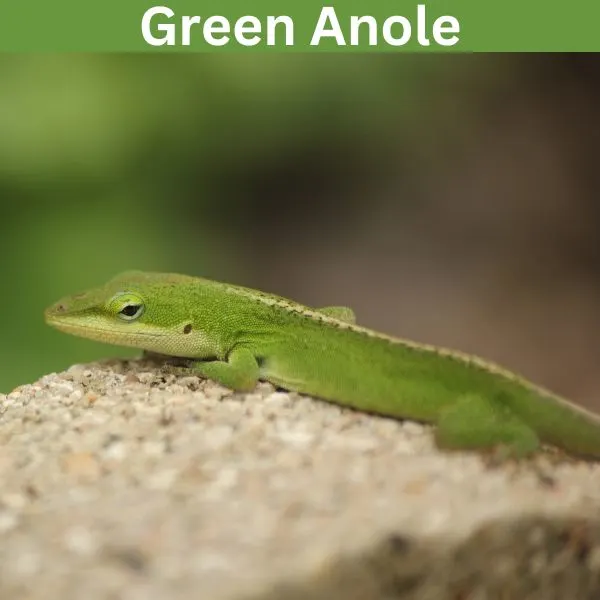
- Experience Level: Beginner
- Family: Dactyloidae
- Scientific Name: Anolis carolinensis
- Other Names: American anole, Red-throated anole
- Adult Size: 5 to 8 in. (12.7 to 20.32 cm.)
- Lifespan: 5 to 8 years
- Average Price Range: $10
Green anoles are a lizard found all across Georgia, and are native to the southern United States. This species is arboreal and enjoys climbing on trees, houses, and other structures. Green anoles live in a variety of habitats like swamps, woodlands, wooded beaches, and urban areas. These lizards are active during the day and enjoy basking in the sun in the morning.
Green anoles are able to change their shade to help them better blend into their habitat. They range in colors from tan to green, and their mood, and environment affect their shade. Green anoles are medium size and have pointed heads. Males have a dewlap under their necks, which have a reddish shade in the breeding season.
In the spring and summer months, these lizards become very territorial since it is the breeding season. Females lay their eggs in moist, and dark environments, which hatch in five to seven weeks. Small insects, spiders, and plant material like flowers or fruit are what these lizards eat. They are very common in their range and have a stable population.
2. Brown Anole
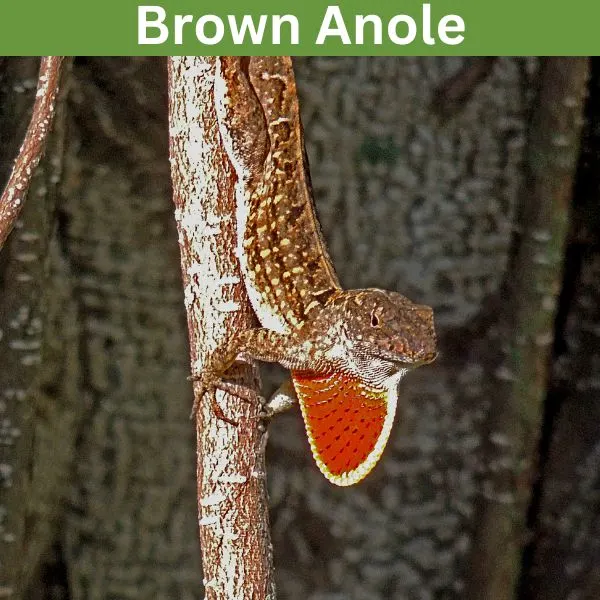
- Experience Level: Beginner
- Family: Dactyloidae
- Scientific Name: Anolis sagrei
- Other Names: Bahaman Anole, Cuban Brown Anole
- Adult Size: 5 to 9 in. (12 to 22.86 cm)
- Lifespan: 5 years
- Average Price Range: $10
Brown anoles are an invasive lizard to Georgia, and are originally native to Cuba, and the Caribbean. These lizards are very rare in the state, and only found in the far south near Florida. Brown anoles can compete with green anoles since they both live in similar conditions. Sub-tropical woodlands are the habitat this lizard lives in.
This lizard has brown, to grayish coloring, and may have a white stripe running down their body. They have reddish, or orange coloring under their chin in the breeding season. The brown dull coloring and the blunt head are what distinguish this lizard from the green anole.
Brown anoles are active during the day and are more common during the warm season of the year. They enjoy climbing on trees, fences, or logs and will hide under debris when resting. Insects like beetles, and other small invertebrates are what these lizards eat. Brown anoles can be a threat to the native animals that live in Georiga since they can take away the resources from the native lizards.
Anguidae
3. Eastern Glass Lizard
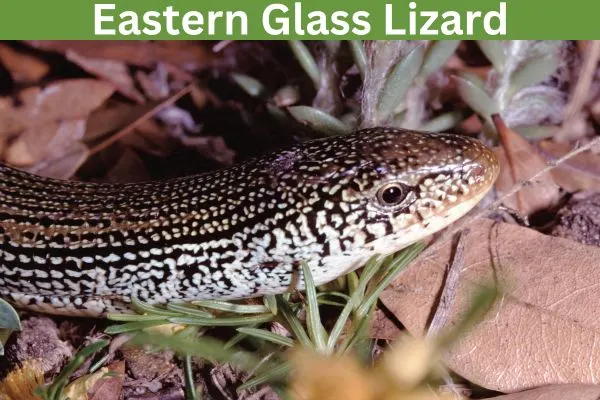
- Experience Level: Intermediate
- Family: Anguidae
- Scientific Name: Ophisaurus ventralis
- Other Names: n/a
- Adult Size: 18 to 43 in. (46 to 108 cm.)
- Lifespan: 10 to 30 years
- Average Price Range: $50
Eastern glass lizards are native to the southeastern corner of the United States. This lizard is found in the southern half of Georgia and lives in sandy and wetland habitats. Eastern glass lizards are very secretive and live in burrows, and often hide under debris. These lizards are active during the day but are not seen often.
Eastern glass lizards have no legs, and a body similar to a snake. This lizard has tan, olive, or green coloring. They have a dark mottled pattern on them and a yellowish belly. Compared to snakes eastern glass lizards have no fangs, blinkable eyelids, and ear holes.
The mouth of the eastern glass lizard can’t extend large like a snake, and they only eat animals that can fit into their mouths. These lizards are able to break off their tail to defend themselves, which grow back, but smaller. Eastern glass lizards eat animals like insects, rodents, and smaller lizards.
4. Mimic Glass Lizard
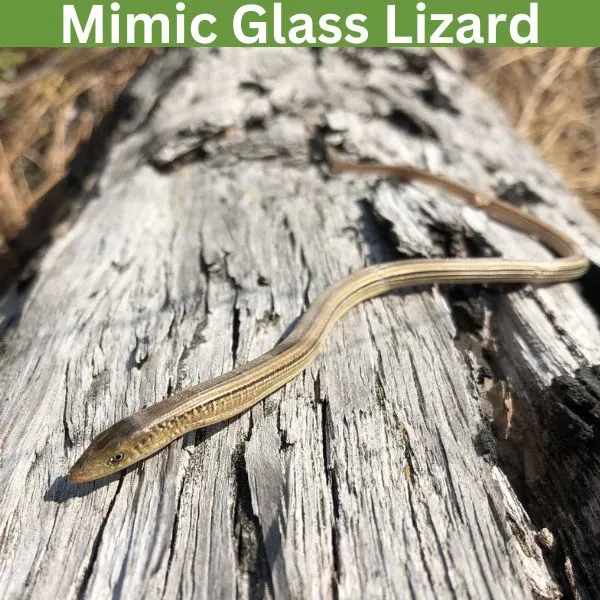
- Experience Level: Intermediate
- Family: Anguidae
- Scientific Name: Ophisaurus mimicus
- Other Names: n/a
- Adult Size: 15 to 26 in. ( 38 to 66 cm.)
- Lifespan: 10 to 30 years
- Average Price Range: $50
The mimic glass lizard is one of the few types of glass lizard species that lives in Georiga. This species is found in the southwestern coastal regions of the United States from North Carolina to Louisiana. Mimic glass lizards can be found in forests and wet prairie habitats. They have a population considered stable but are rare lizards.
Mimic glass lizards have a snake-like body, with dark brown, to black coloring. They have a middorsal stripe running down them, with spots that appear on their back. Like other glass lizards, this species has movable eyelids, with ear holes. Mimic glass lizards are one of the smallest glass lizards that live in Georiga.
Small insects and spiders are what this lizard eats, and they forage during the day. Mimic glass lizards are harmless to humans, but some may confuse this lizard with a snake. Grabbing them can trigger them to drop their tail, which is used to help them escape predators like predatory birds, snakes, and mammals.
5. Island Glass Lizard

- Experience Level: Intermediate
- Family: Anguidae
- Scientific Name: Ophisaurus compressus
- Other Names: n/a
- Adult Size: 15 to 24 in. (38 to 61 cm.)
- Lifespan: 10 to 30 years
- Average Price Range: $50
In Georgia the island glass lizard lives in the southeastern region of the state. They live in dry scrub habitats and are a terrestrial species. Island glass lizards are native to the southeastern United States, and have a very small range including Florida, and South Carolina.
Island glass lizards are one of the smaller glass lizards that live in Georiga. They have a brown, or olive coloring, with dark lines on their side. This species has a yellowish underside, and a speckled pattern near their sides.
The small range, and cryptic nature is why island glass lizards are rarely seen, and difficult to study. These lizards are mainly active in the day, and may spend their time not active in burrows, or under debris. Spiders, insects, and other small invertebrates are what this species eats.
6. Slender Glass Lizard
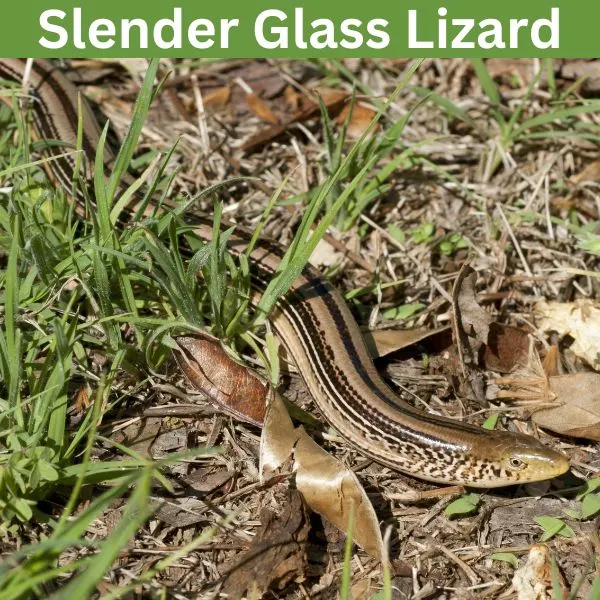
- Experience Level: Intermediate
- Family: Anguidae
- Scientific Name: Ophisaurus attenuatus
- Other Names: n/a
- Adult Size: 22 to 46 in. (55.88 to 116.84 cm.)
- Lifespan: 10 to 30 years
- Average Price Range: $50
The slender glass lizard has a large range, and is native to the southern United States. This species of lizard lives in sandy habitats, and are common in the Coastal Plains. Slender glass lizards compared to species like the eastern glass lizard prefer to live in more dry habitats.
Slender glass lizards are one of the largest glass lizards that live in Georgia. This lizard has brown, yellowish, to tan color. They have a dark stripe, and mottled markings on their sides. Some slender glass lizards have a dark stripes running down their backs. The dark marking under the lateral grooves of this species is the easiest way to identify them from other glass lizards.
Prey like spiders, insects, and small rodents is what this lizard eats. They breed in the summer, and females lay their eggs in dark, and secluded areas. Slender glass lizards will stay with their eggs until they hatch later in the summer. This species has a stable population overall, but in their habitat destruction is a threat they face in some regions.
Phrynosomatidae
7. Eastern Fence Lizard
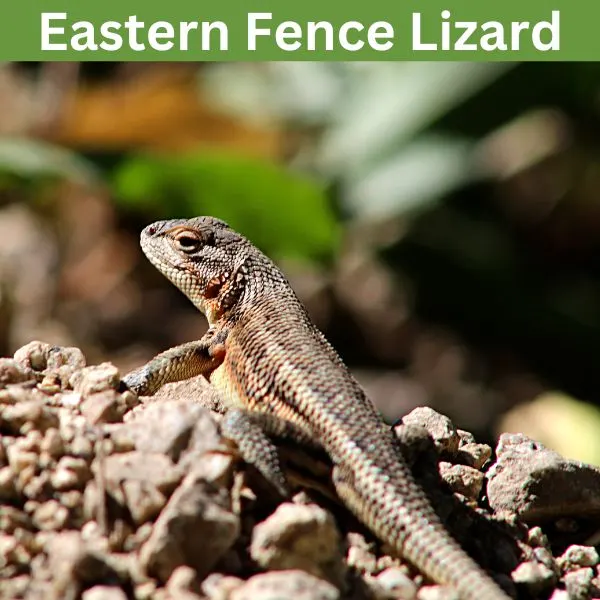
- Experience Level: Intermediate
- Family: Phrynosomatidae
- Scientific Name: Sceloporus undulatus
- Other Names: Prairie lizard, fence swift, pine lizard, gray lizard
- Adult Size: 4 to 7.25 in. (10.16 to 18.41 cm.)
- Lifespan: 4 years
- Average Price Range: $20
The eastern fence lizard is native to the eastern United States. You may find this lizard all across Georgia, and they live in oakwoods, urban, and grassland habitats. Eastern fence lizards are active in the day, and they are capable of living in cold regions. They will lay larger eggs, but lay less of them if living in a cold area, and can even survive cold freezes.
Eastern fence lizards have one of the most keeled scales when compared with other lizards in Georgia. These lizards have gray, tan, to nearly black coloring, and have dark cheveron markings covering them. Males may have blue coloring on their underside, on their bellyes and neck.
This lizard feeds on insects, spiders, and other invertebrates. They are a sit and wait, ambush predator. Fire ants are one of this species main predators, as they live in similar regions. The speed and reaction time of this lizard help them escape predators when attacked.
Scincidae
8. Little Brown Skink
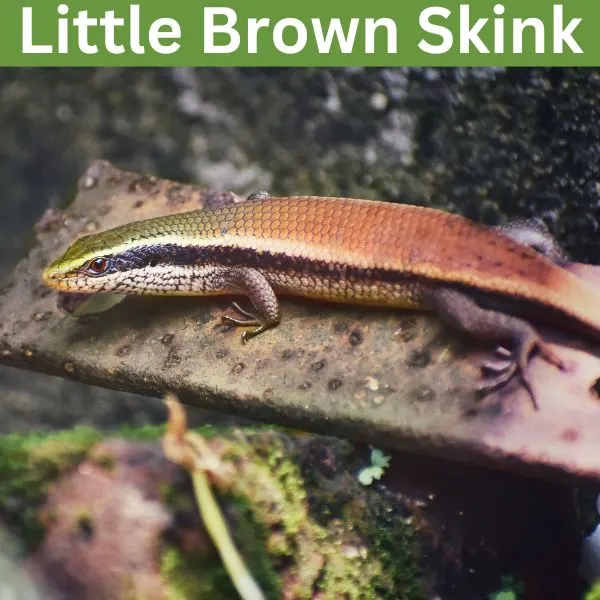
- Experience Level: Beginner
- Family: Scincidae
- Scientific Name: Scincella lateralis
- Other Names: Ground Skink, Brown-backed Skink
- Adult Size: 3 to 5.25 in. (7.62 to 13.3 cm.)
- Lifespan: 2.5 years
- Average Price Range: $5
Little brown skinks can be found all across Georgia. The range of this lizard covers the southern United States. Woodland habitats, and other places with loose leaf litter and soil is where this species lives. They are a fossoiral lizard, needing loose soil to burrow.
The color of this skink is tan, to copper. They are one of the smallest lizards native to North America, and have small limbs and a slender body. Little brown skinks have a dark stripe on their sides and may be covered in a dark-speckled pattern. They have a smooth and moist appearance, and their size is their most identifying trait.
Little brown skinks may not be seen since they hide in leaf litter. They feed on small terrestrial insects like earthworms. Ring-necked snakes, cats, and ground-foraging birds like turkeys are the biggest predatory threats this lizard faces.
9. Coal Skink
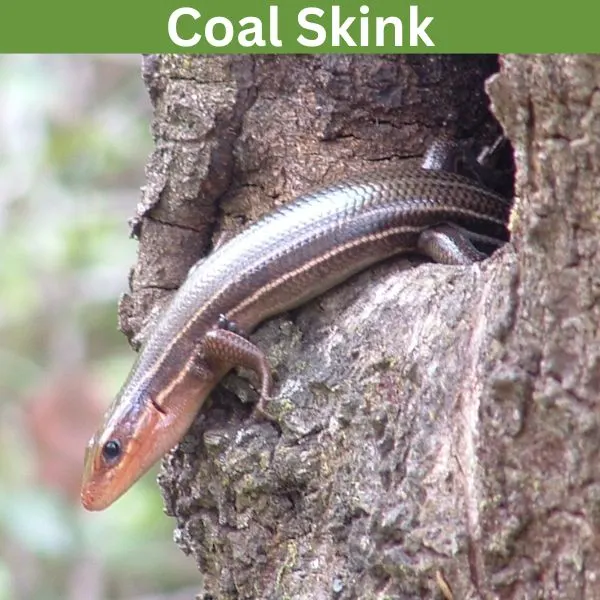
- Experience Level: Intermediate
- Family: Scincidae
- Scientific Name: Plestiodon anthracinus
- Other Names: n/a
- Adult Size: 5.1 to 7.1 in. (13 to 18 cm.)
- Lifespan: 6 years
- Average Price Range: n/a
Coal skinks have a small range within Georgia, found in a small portion of the western mountainous regions of the state, and the northeastern corner near South Carolina. Forest habitats are where this lizard is seen most in the state. They are not very common, and not much is known about their habitats. This species often hide under debris like rocks, logs, or other things near water.
Coal skinks are a medium-sized species, with gray, brown, or black coloring. They have a blue tail when young, which fades with age. Yellowish stripes appear on this lizard’s sides, and they have two on each of their sides. Red coloring may appear on males’ cheeks during the breeding season.
Coal skinks are very secretive, and if approached by a potential predator they will dive into the water. This lizard feeds on insects, and other invertebrates, and is active in the spring to fall months. Spring is when this lizard breeds, and they lay up to 13 eggs, placing them in a secluded, moist area.
10. Mole Skink
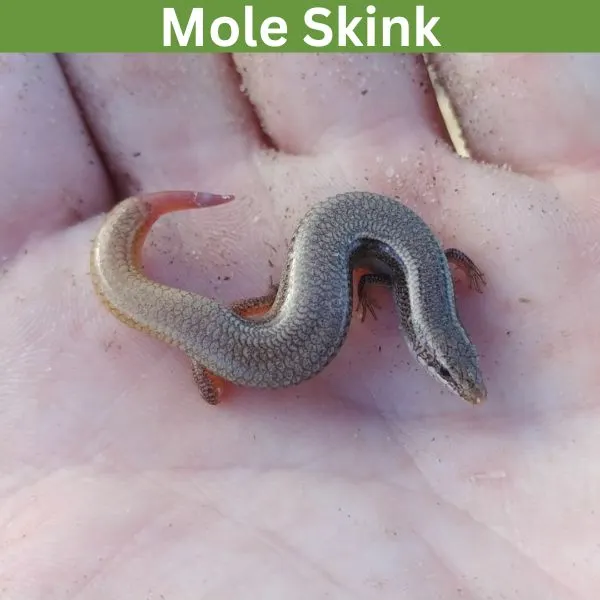
- Experience Level: Intermedate
- Family: Scincidae
- Scientific Name: Plestiodon egregius
- Other Names: n/a
- Adult Size: 3.5 to 6 in. (9 to 15 cm.)
- Lifespan: n/a
- Average Price Range: n/a
Mole skinks are mainly found in Florida, but are seen in some nearby states like Georiga. These lizards are found in Georgia in the southern half of the state. They are a burrowing species and need loose and sandy soil in their habitats. Hot and dry places are where this lizard lives, and they are generally not seen since they burrow, or hide under debris like logs. Sandhills, scrub, and coastal dunes are the habitats this lizard lives in.
Mole skinks when born have a bright blue tail, which can make up around half their length. This lizard has a tan, to copper shade, small legs, and a slender body. In the breeding season, males get more colorful and can be orange on their sides.
Insects like roaches, crickets, and beetles are what this lizard eats. Mole skinks are under threat mainly due to habitat loss, and pollution. These lizards are like moles as they spend most of their life underground. Mole skinks have around 5 subspecies, but only one of them lives in Georgia.
11. Common Five-lined Skink
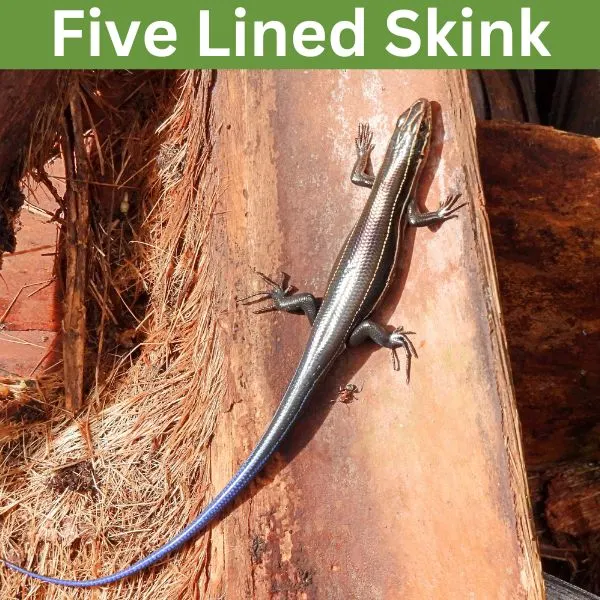
- Experience Level: Intermediate
- Family: Scincidae
- Scientific Name: Plestiodon fasciatus
- Other Names: American
- Adult Size: 4.9 to 8.5 in. (12.5 to 21.5 cm)
- Lifespan: 6 years
- Average Price Range: $12
Common five-lined skinks are found all across Georgia. These lizards live in many habitats like woodlands, grasslands, and urban areas. They are common near water sources like lizards. Common five-lined skinks enjoy climbing but are usually found on the ground.
This skink has a black to tan coloring. When born they have a bright blue tail, and overall their colors fade with age. These lizards are named after the five yellowish lines that appear on their body. In the breeding season, males may have reddish or orange heads.
Some may believe this lizard is venomous due to their bright colors, but overall they are harmless. Common five-lined skinks feed on small insects. They are able to drop their tail and grow it back if attacked.
12. Southeastern Five-lined Skink
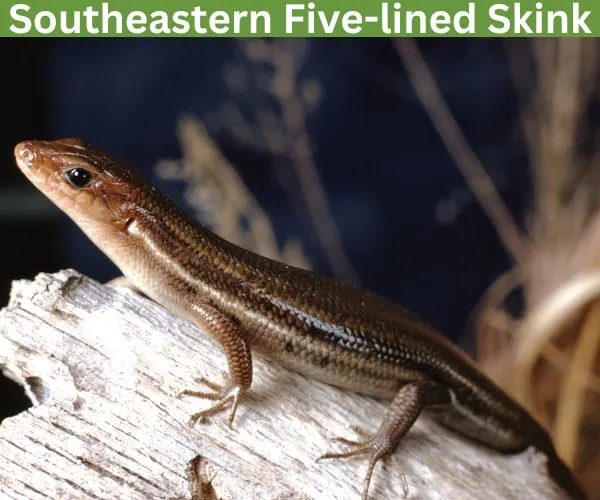
- Experience Level: Beginner
- Family: Scincidae
- Scientific Name: Plestiodon inexpectatus
- Other Names: n/a
- Adult Size: 5.5 to 8.5 in. (13.97 to 21.59 cm.)
- Lifespan: 6 years
- Average Price Range: n/a
The southeastern five-lined skinks is one of several skink species in Georiga. This lizard is active during the day. They live in wooded habitats near water sources like river. This lizard can be found in most of Georiga but the far northern region. Southernesatern five lined skinks are native to the southeastern United States.
Like other skinks, these lizards have a blue tail when young. They have five stripes that run down their body and have tan, olive, or nearly black coloring. This species looks very similar to the common five-lined skink. The common five-lined skink is slightly smaller and has broader stripes, but the two are very difficult to tell apart.
Insects like crickets and grasshoppers are what this lizard eats. They may sometimes be kept as pets, and have a stable population in their range. Southeastern five-lined skinks breed in the spring and lay around 6 to 12 eggs. Females will protect their eggs until they hatch in the summer.
Gekkonidae
13. Mediterranean House Gecko
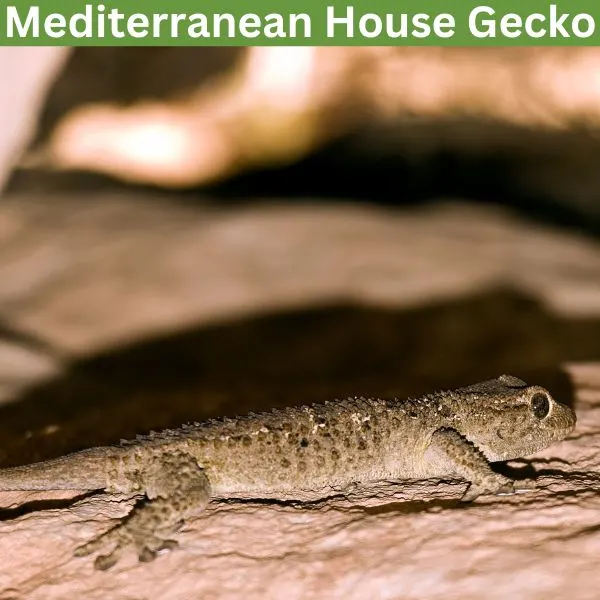
- Experience Level: Beginners
- Family: Gekkonidae
- Scientific Name: Hemidactylus turcicus
- Other Names: Moon Lizard, Turkish Gecko
- Adult Size: 4 to 5 in. (10 to 13 cm.)
- Lifespan: 3 to 9 years
- Average Price Range: $10
The Mediterranean house gecko is a lizard native to the Mediterranean. This gecko has been introduced to Georgia and many other states. Urban areas and man-made buildings like warehouses are where this lizard is common. The populations of these lizards are scattered across Georgia and are usually restricted to urban areas.
Mediterranean house geckos are medium-sized, with very bumpy skin. They have to pads that help them stick to surfaces, and yellow eyes with elliptical pupils. Tan, cream, to purplish, is the color of this lizard.
Insects make up the diet of this lizard, and they are active at night. Near light sources are where this gecko may be seen, and they hunt in other places that get lots of insect traffic.
The adaptability of this gecko is why they have managed to become invasive in so many regions. When breeding they will make a squeaking noise to deter other lizards. Thye lay up to two clutches with several eggs, placing them in moist and secluded areas. During the day this lizard is inactive, and hides in crevices like under tree bark till night.
Teiidae
14. Six-lined Racerunner
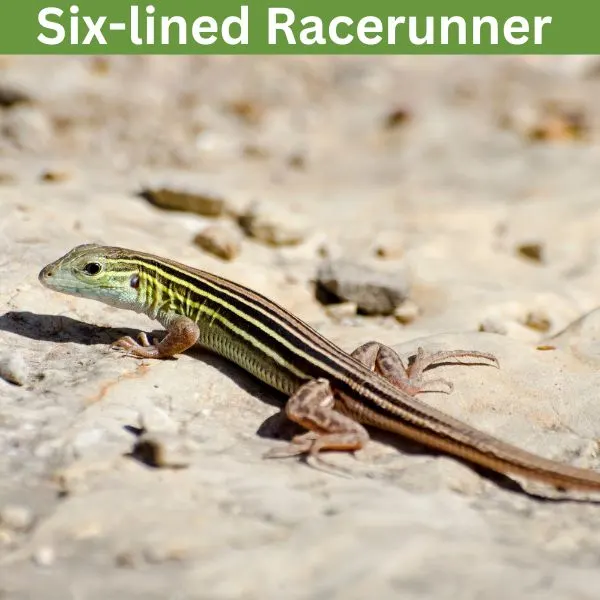
- Experience Level: Intermediate
- Family: Teiidae
- Scientific Name: Aspidoscelis sexlineata
- Other Names: Sandlapper lizard
- Adult Size: 6 to 9.5 in. (15 to 24 cm.)
- Lifespan: 4 to 5 years
- Average Price Range: $30
The six-lined racerunner is the only racerunner species that lives in Georiga. This species is found all across the state. They live in fields, woodlands, and sand dune habitats. This lizard is active during the day, is very heat tolerant, and can even be active in hot periods. Six-lined race runners are common, and native to the southeastern United States.
Six-lined race runners are named after the six yellowish lines that run down their bodies. This species has black to olive coloring. They have slender bodies, with blue tails when born.
This lizard is very quick and uses their speed to catch prey and escape from predators. Six-lined race runners are common in dry habitats and rarely visit moist environments. This lizard feeds on insects, and spiders.
15. Argentine Black and White Tegu

- Experience Level: Intermediate
- Family: Teiidae
- Scientific Name: Salvator merianae
- Other Names: Huge Tegu
- Adult Size: 2.5 to 4.5 ft. (76.2 to 137 cm.)
- Lifespan: 20 years
- Average Price Range: $200
Native to South America, the black and white tegu is a species that has been introduced to Georgia due to the pet trade. These lizards are extremely rare to come across and are considered invasive since they can negatively affect the habitats in the state. Currently, these lizards have a population in the southeast region of Georgia, but they are trying to eradicate them before they can do harm.
These lizards are extremely large, and have beaded scales. They have black and white coloring and are capable of weighing more than 10 lbs. Black and white tegus have robust bodies, with long pink tongues.
The size of these lizards make them a threat to other reptiles, and mammals. They can feed on ground nesting birds, and other native animals to Georgia. This species is a common pet, but many are not ready to handle the care of such a large lizard, which is why they may be released into the wild.
Questions About Lizards in Georgia
Are the lizards in Georgia dangerous?
While some lizards in Georiga may have bright colors there are none that are poisonous, or venomous. Lizards are typically harmless, and if approached in the wild will generally flee. If cornered lizards may bite, but no lizards in the state are dangerous to humans.
What is the largest lizard in Georgia?
The slender glass lizard is the largest native lizard in Georiga, but may not be seen due to their secretive nature. These lizards look more like snakes and have long and thick bodies.
What is the most common lizard in Georiga?
Some of the lizards in Georgia like green anoles, eastern fence lizards, and skinks are very common to find in the state during the right seasons. Lizards that live in urban habitats, and are active in the day are the types that you are most likely to come across.
Wrapping up
There are around 15 lizards species that live in Georgia, and more may appear since species can be transferred to new areas. Invasive lizards can occur due to people releasing their pets into the wild, or lizards traveling by cargo ships, and other trading methods. The lizards in Georgia are essential to the ecosystems they live in and help keep balance in the state’s wilderness.
Protecting the homes that lizards live in is essential in maintaining healthy populations, and preventing them from going extinct. Lizards are just a few of the amazing animals that rely on Gerogias wilderness. Habitat loss, pollution, and invasive species are threats to look out for that can affect lizards, and their population.
The lizards in Georgia are fun to find in the wild, but some can even make good pets for the right owner. Hopefully, this lizard was helpful in showcasing some of the amazing animals in Georgia.
Lizards in other nearby states
